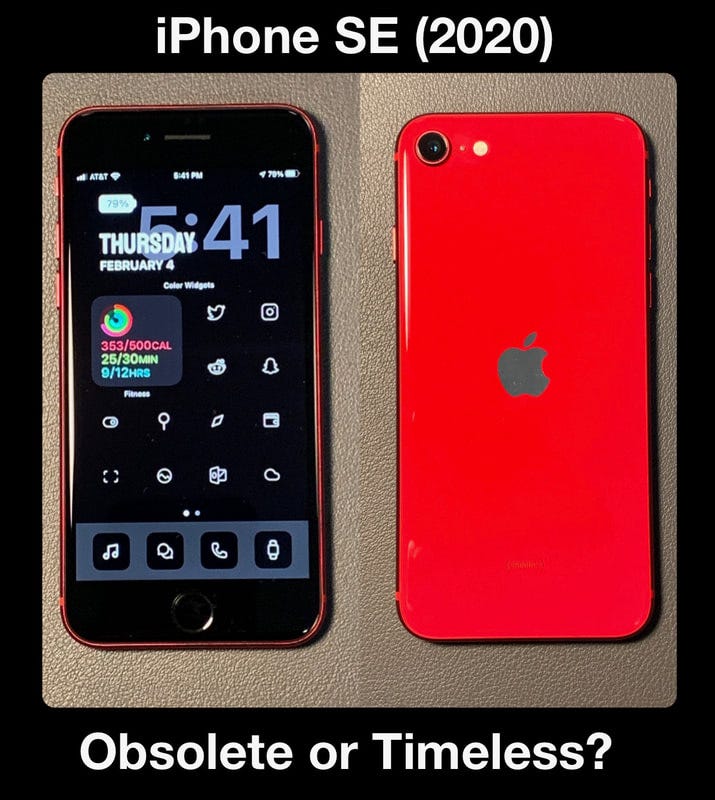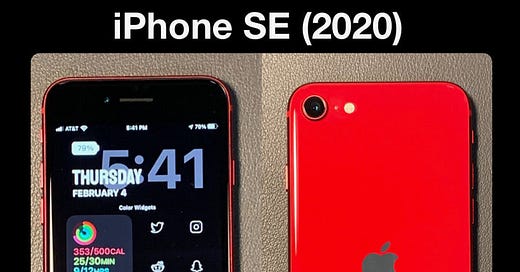iPhone SE (2020): First Impressions!

Brady Snyder
The design, home button, and gigantic black bezels of the iPhone SE will immediately invoke one of two emotions: nostalgia or disgust. On one hand, the design is familiar and has been perfected. On the other hand, it shares the same dimensions of the iPhone 7 (released in 2016), and its ~1/2 inch bezels on the top and bottom of the front glass are a holdover of an obsolete design that has been all but banished from modern smartphones.
This wasn't a purchase I wanted to make, nor was this a post I had my eyes on writing. It quite literally fell into my lap, after my iPhone XS Max fell three feet into the tile floor in my dorm room. Yes, you read that right—the 256 GB iPhone XS Max that retailed for $1249 on release day a little over two years ago.
This may be precisely the position you find yourself in at some point, considering that as soon as you crack the back glass of a modern iPhone, the repair price can be anywhere between $350 and $550. Repair isn't even an option at that price, so let's say you walk into a carrier store and ask them for the cheapest new iPhone they have. They'll hand you this iPhone SE at $399 (I will end up paying $150 through an AT&T installment plan).
Maybe you haven't broken your phone—you're due for an upgrade instead—and you come to the realization that paying over a thousand U.S.D. for a phone that a) may break or b) will be outdated in a few years is absurd. Here are a few questions you might have:
How much of the premium iPhone experience do you get at just a few hundred dollars? Is there feature parity between devices? Will I be disappointed switching from a modern iPhone to an SE down the road? My first impressions may surprise you.

Brady Snyder
Undoubtedly the first thing you'll notice about the iPhone SE, especially coming from a modern iPhone is the display. Compared to the aforementioned iPhone XS Max's 6.5 inch OLED display, the iPhone SE's 4.7 inch LED display feels minuscule. The bezels are massive compared to the thin bezels that line the exterior of modern iPhone displays, though their uniformity will be preferred by some who hate the horizontal asymmetry caused by the Face ID notch on modern iPhones.
In fact, after a few hour learning curve, I actually preferred the smaller iPhone SE's display to the XS Max's. The smaller form factor of the SE made typing with both hands much easier than the XS Max, and fit comfortably in the hand compared to the long XS Max.
Unfortunately, I've also noticed some significant cons to the SE's display in just about 24 hours of use.
First off, the LED display. A light-emitting diode (LED) display has a backlight, meaning light is shined through all of the display's pixels, even those that are black. On an organic light-emitting diode (OLED) display, which the Pro and Max line of iPhones have used for a few generations, has lights on each individual pixel, meaning that black pixels can be turned off completely. This in turn produces much deeper blacks than an LED display. If you've used an OLED before, you'll notice the backlight bleeding through blacks and grays immediately.
Second, a feature introduced with Face ID called "Tap to Wake." It's that feature that allows you to tap the front of your iPhone and wake it immediately, and it's absent on any iPhone without Face ID. This means that you'll have to physically press the home or power buttons to wake the display. It shouldn't be a deal breaker, but it has been a noticeable deterrence in the first day of use.

Apple
Luckily, in my first impressions, this is where the cons end. The A13 Bionic silicon powering the iPhone SE is the exact shame chip powering the iPhone 11 Pro Max, despite the 11 Pro Max costing almost five times more. It's also powering a lower-power and smaller screen, which should offer great performance and even better battery life—and so far, it has delivered. The SE feels snappy and fluid through iOS 14.4 and I haven't had to frantically worry about battery life since I got my hands on it.
In a pandemic, Touch ID is absolutely life-changing. Wearing a mask? Just press a finger on the home button and you're device is unlocked. No more typing in passwords in crowded public places anymore, which is a huge security risk. Touch ID should be a downgrade from Face ID, but in early 2021, it doesn't feel that way.
All in all, my first impressions are surprisingly solid considering I'm spending a fraction on the SE than my last iPhone. If you're worrying about having to switch back to an "obsolete" design, fret no more. The nostalgia I felt unboxing this phone cements the design as timeless to me, and the transition has been seamless through the first day. Stay tuned for an in-depth review and comparison of every aspect of the iPhone SE (2020) to its iPhone competitors.




